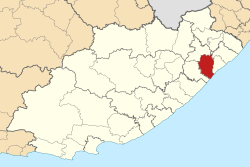Nyandeni | |
|---|---|
 Location in the Eastern Cape | |
| Coordinates: 31°27′S 28°57′E / 31.450°S 28.950°E | |
| Country | South Africa |
| Province | Eastern Cape |
| District | OR Tambo |
| Seat | Libode |
| Wards | 31 |
| Government | |
| • Type | Municipal council |
| • Mayor | Mesuli Ngqodwana (ANC) |
| • Speaker | Noziphiwo Matanda (ANC) |
| • Chief Whip | Mcebisi Robert Mtobela (ANC) |
| Area | |
| • Total | 2,474 km2 (955 sq mi) |
| Population (2011)[2] | |
| • Total | 290,390 |
| • Density | 120/km2 (300/sq mi) |
| Racial makeup (2011) | |
| • Black African | 99.4% |
| • Coloured | 0.3% |
| • Indian/Asian | 0.1% |
| • White | 0.1% |
| First languages (2011) | |
| • Xhosa | 95.3% |
| • English | 2.0% |
| • Other | 2.7% |
| Time zone | UTC+2 (SAST) |
| Municipal code | EC155 |
Nyandeni Municipality (Xhosa: uMasipala wase Nyandeni) is a local municipality within the OR Tambo District Municipality, in the Eastern Cape province of South Africa. Its administrative seat is the town of Libode. The entire municipal area falls within the former Transkei Bantustan area. The urban population is mainly located in the two small towns of Libode and Ngqeleni.[3]
Scattered, low-density rural settlements dominate the municipality. 79% of households reside in traditional or village type settlements. These settlements are loosely scattered throughout the entire municipal area and are surrounded by communal grazing and arable lands. The majority of residential structures are self-built. Apart from a few trading stores, there is little sign of any significant economic activity within the rural settlements.[4] Many of the families in the rural regions of the municipality were formerly supported by men who worked as migrant labour in local mines. Subsequent retrenchment at the mines has left these communities with scant means to survive.[4] About 77% of households can be regarded as indigents with access to either no income or incomes of less than R800 (US$108) per month.[3]
Most of the education institutions in Nyandeni cater to lower level schooling. Of the 426 schools in the Nyandeni area, 64% are overcrowded or highly overcrowded, according to the OR Tambo District office.[4] The spread of HIV/AIDS is an extremely severe and urgent problem in the area. In 2009, the HIV/AIDS prevalence rate was as high as 50%-60% among tested cases; these cases were mainly females who participated in voluntary testing during their regular pregnancy visits to local clinics.[4]
- ^ "Contact list: Executive Mayors". Government Communication & Information System. Archived from the original on 14 July 2010. Retrieved 22 February 2012.
- ^ a b c "Statistics by place". Statistics South Africa. Retrieved 27 September 2015.
- ^ a b "NYANDENI LOCAL MUNICIPALITY (Serving Libode and Ngqeleni in the Eastern Cape Province)". www.nyandenilm.gov.za. Archived from the original on 26 October 2007.
- ^ a b c d "Nyandeni Integrated Development Plan: Review 2009/2010." Nyandeni Local Municipality. Retrieved 22 October 2009.
